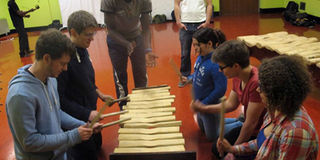Playing the Amadinda around the world

Lawrence Okello (3rd L) instructs some of the students from the University of Performing Arts and Music, Vienna, Austria on how to play the Amadinda. Courtesy photo
What you need to know:
Spreading wings. With the aim of promoting Ugandan music and instruments, Lawrence Okello embarks on a journey to Europe to fulfill his dream.
“When I was starting my music journey way back as a child, one of my future dreams was to perform to big crowds and also take Ugandan music across the world,” Lawrence Okello once told Saturday Monitor in an interview.
True to his child-hood dream, Okello is currently on a mision to promote Ugandan music and musical instruments in as many countries as he can, starting with Europe.
Among the various Ugandan musical instruments, he chose to start with the Amadinda (xylophones). He got the idea in 2013 while in Egypt during the Nile Project music tour. During a chat with one of the agents of the Nile Project, Horst Watzl from Vienna Institute of Development Corporation in Austria, Okello told him he wanted to promote Ugandan musical instruments in Austria and other countries. He chose to start with Amadinda because he believed they would easily be adapted worldwide like the djembe drums. Watzl then introduced Okello to the University of Vienna, which accepted to work with him.
Okello created Amadinda Uganda, a group of six instrumentalists. The members include Nuhu Nabeeta, a dancer and vocalist, Arafat Bogere, a vocalist who can also play Endere, Amadinda and drums, Rashid Buyinza, a vocalist and can play Endingidi and Amadinda. The others are Monica Komol, a dancer and vocalist, Jamilah Nassanga, also a dancer and vocalist. All the members were sourced from various traditional music groups in Uganda, including Ndere Troupe, Pearl Rhythm and Crane performers.
The aim of the group is to let people know and appreciate Ugandan traditional music. The group members are also multi-instrumentalists, able to play various local musical instruments such as the Adungu, among others.
Through Amadinda Uganda, the group has worked with Uni-percussion Vienna from the University of Performing Arts and Music, Vienna, Austria last year. After one week of rehearsals, the two groups came up with different compositions, which later were blended to make different compositions. It was a traditional classic type of music performed by a cypher of orchestras. The two groups’ union climaxed in a one and half-hour non-stop performance at the University in Austria. They exchanged and learnt from each other through hands on instruments notations. They also performed in cities of Hungary and Slovakia. On top of the Amadinda, Okello’s group also used instruments such as, Adungu, Endingidi, Enkwanzi, Engoma and Endere.
Early next year, the group together with Uni Percussion from Austria will have a concert in Uganda. The group will also continue to other countries in Europe.
During their stay at the Austrian university, music students were taught how to play the Amadinda. “For the percussion students, it was much easier, though certain styles disturbed them,” Okello says.
The amadinda
Amadinda is a wooden xylophone played by two or more people. It is a type of xylophone called log xylophone. In many villages in Uganda, the Amadinda comprises 12 wooden bars placed on two fresh banana stems. Sticks are inserted into the stems as separators between the bars. Others use four sturdy mounting wooden posts to hold the bars. The Amadinda is played by hitting the bars at the end with a stick. The tip of the bar is hit with the middle of the stick in an angle of about 45 degrees.
The hands are moved in parallel. The movement should come from the wrist, and the arms should be moved as little as possible, though there are special techniques used only by master players.
The Amadinda tradition is one of the most interesting musical styles in Uganda and many tribes play them. The Amadinda is played by the Baganda, Basoga, Bagweri, Alur, Lango, Bakonjo, Bamba and Banyoro, among others.




